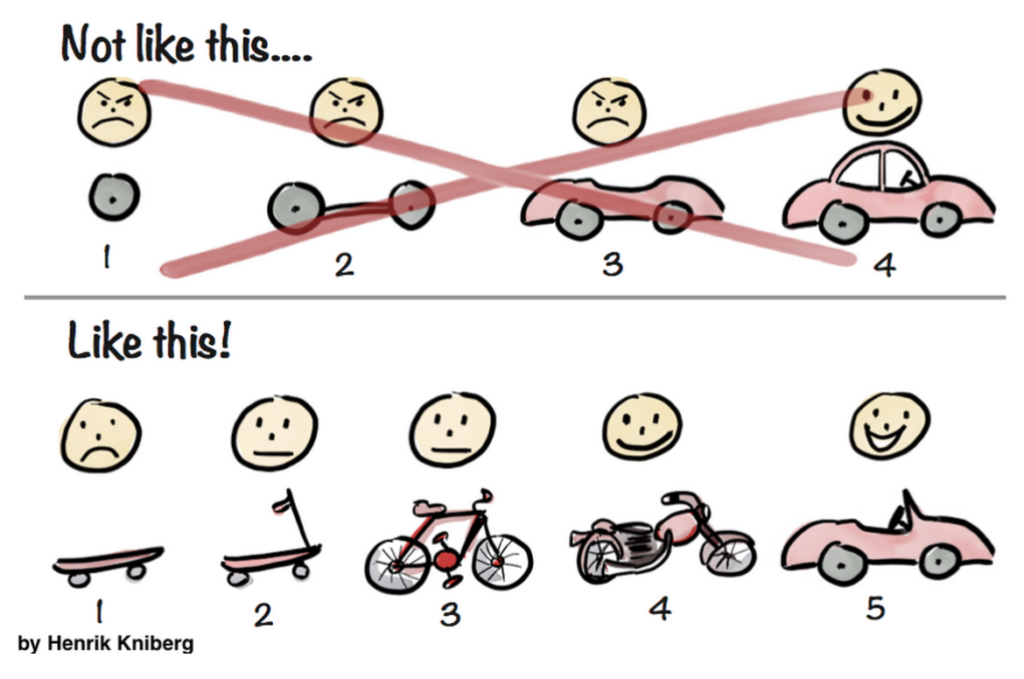Kinds of MVPs
6 min
0+

No, we’re not talking first release version MVP here. Instead, we show some experiment MVPs which quickly help validate hypotheses without burning your bank.
At the core of Agile development stands the idea of a Minimum Viable Product (MVP). A MVP as we usually know it is a first version of a product with just enough features to be usable by early customers who can then provide feedback for future product development.
A quick reminder: An MVP is not a half-finished product which does not really solve a user’s problem as depicted by this graphic which everyone has seen at least once in their lifetime:

credit to Henrik Kniberg, Spotify
And an MVP is also not a undelightful product which works but is really ugly to use for users:

credit to Roy Scholten
Instead, an MVP version of a product does solve the core problem a user has, it works well, is delightful and easy to use, it just does not focus on other use cases and user problems yet which may be out there as well. It’s purpose is to (dis-)confirm your initial hypotheses on a potential market gap / user need.
This is the type of MVP people usually refer to when using the term. But often, even this version takes quite some resources to build. What if you don’t have that but still want to validate if you’re on the right track, be it to convince investors or just to know if it’s worth to throw your team’s resources on building such a kind of MVP?
For this, there is another, very scaled-back type of MVPs which is used to run experiments and quickly help validate a hypothesis. In this article, we want to introduce some of them:
1. Preorder MVP
A preorder MVP is the ideal tool to find out if people are actually interested enough in your idea to open their wallets for it. It’s the ideal tool to gather some initial data if this idea is worth pursuing or to pitch in front of potential investors in case you seek seed funding.
Simply create a fake marketing website for your product, describing it as if it already existed with the features you feel are important, and put a ‘Buy’ button at the bottom of the site. Then, market this product like it actually exists, take out different display ads, and see how many people click ‘Buy’.
To avoid being completely deceptive, add a note when someone clicks ‘Buy’ that says you haven’t finished building this product, are currently working on it, and they can enter their email address to be updated when you’ve got new information. This is also a nice way to capture a list of customer email addresses you can market to when your product is available.
For an existing product, you could create a ‘New Feature’ section on your website, see how many people watch an explainer video showing how you intend for the feature to work, and use a ‘Learn More’ button instead of a ‘Buy’ button to reveal the truth and again capture email addresses.
2. Email MVP
Similar to the preorder MVP but creating an email takes much less effort than building a website, a product or a feature within a product. If you have existing users, begin by manually creating some emails to see if the response to the email is favorable. If it is, then you can proceed to building the related product features.
If you see that most people are opening the email but not clicking on the call to-action button, then you can conclude that the value proposition is not something attractive.
Interestingly, Ryan Hoover of Product Hunt started off by emailing his idea to a list of people. After receiving rave feedback, he knew the idea was worth pursuing further.
3. Fake Door MVP
A little more low-key than the first two kinds of MVP is the fake door. If you’re thinking about building a new feature into your product, add the UX elements you’d use to enter the feature or trigger the interaction. But rather than actually delivering the feature, provide a notification that the feature’s coming soon. See how many people use your “fake door.” For example, if your hypothesis is that people would find a live group chat feature useful on your online education site, add a ‘Chat’ button and see how many people click it. If only a tiny percentage do, reconsider if it’s worth pursuing this opportunity, depending on the value of those customers vs. the cost of implementing the feature.
4. Concierge MVP
Another type of MVP is a concierge MVP. In it, you’ll manually work with your user just like a real concierge would to perform a task, where the task is the overall focus for your opportunity hypothesis.
If you have a hypothesis that people want a restaurant-recommendation app, you’d act like a human concierge to help them select a restaurant. During this process, you’ll want to explicitly focus on the steps you go through to figure out an answer — which questions matter and which don’t, and what’s involved in completing each step — so that you can eventually automate them.
Looking at this restaurant-app idea: If no one asks for your concierge’s help, that’s a big initial sign that something is wrong. Either you’re not appealing to the right customers or you’re not making your value proposition clear. Then, when someone expresses interest, you’ll manually discuss with that person what type of food she likes and dislikes, what type of restaurant ambience/price point/etc. she’s looking for, and you’ll run a Yelp search for her. You could even offer to arrange transportation. As you go through this process, you’ll find out if customers are interested in the overall idea, which steps are the most useful and what goes into them, which steps are unexpected but delightful (like arranging transportation), and which steps customers don’t care about. This helps you refine your hypothesis and create a better cost/value estimation. For example, maybe you find your customers really want a feature that lets them push a button and simply have a Lyft show up to take them to a nearby open restaurant that they’ll probably like: they care about instant fulfillment over making a reservation and planning.
Many service start-ups initially began with a concierge MVP, helping them gauge interest and better understand the overall problem space and user needs.
5. Wizard of Oz MVP
A Wizard of Oz MVP is another simple type, sometimes the next step after the Concierge MVP. Here, you’ll create a product that looks like it’s fully built to an end customer, but humans are doing the work behind the scenes. The Zappos founder didn’t start by making an e-commerce site or stocking tons of inventory: he took photos of shoes at different shops (with permission), put them online, and when an order came in, he’d manually buy and ship the shoes. But to a user, it looked like Zappos had a full inventory and was a store by itself.
This style of MVP also doesn’t scale, but it’s another way to validate the demand for your opportunity. If you can manually keep up with the demand, this idea probably isn’t worth pursuing. But if people love it and you’re overwhelmed, that’s a good hint it’s time to automate it.
6. Piecemeal MVP
This one falls in-between the Concierge MVP and the Wizard of Oz MVP. With a Piecemeal MVP, you use existing tools and services to deliver a functioning product to your customers. Typically, you use a number of existing technologies (that don’t always integrate so well together) so mean more human resource is required to manage the process. Using existing services will save you time and money by building your own technology and infrastructure.
There are many more such MVPs and you can become creative in gluiding them together. The key to remember with every experiment is that you want to keep it simple and cheap. You don’t want to spend so much time designing the perfect A/B test or preorder MVP that you’re burned out before you’ve even run the experiment. You’re going to throw away every experiment, regardless of the result. If the result’s positive, you’ll have to build the product or feature for real.
Got questions, ideas or remarks on this method? Join the conversation on